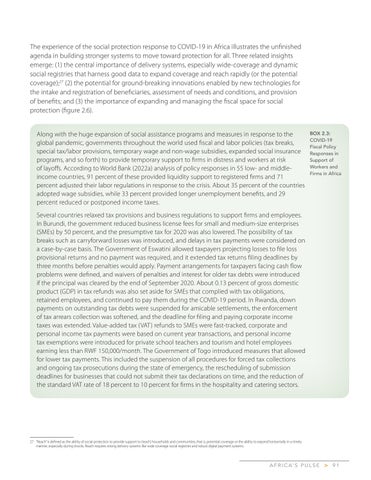The experience of the social protection response to COVID-19 in Africa illustrates the unfinished agenda in building stronger systems to move toward protection for all. Three related insights emerge: (1) the central importance of delivery systems, especially wide-coverage and dynamic social registries that harness good data to expand coverage and reach rapidly (or the potential coverage);27 (2) the potential for ground-breaking innovations enabled by new technologies for the intake and registration of beneficiaries, assessment of needs and conditions, and provision of benefits; and (3) the importance of expanding and managing the fiscal space for social protection (figure 2.6). Along with the huge expansion of social assistance programs and measures in response to the global pandemic, governments throughout the world used fiscal and labor policies (tax breaks, special tax/labor provisions, temporary wage and non-wage subsidies, expanded social insurance programs, and so forth) to provide temporary support to firms in distress and workers at risk of layoffs. According to World Bank (2022a) analysis of policy responses in 55 low- and middleincome countries, 91 percent of these provided liquidity support to registered firms and 71 percent adjusted their labor regulations in response to the crisis. About 35 percent of the countries adopted wage subsidies, while 33 percent provided longer unemployment benefits, and 29 percent reduced or postponed income taxes.
BOX 2.3: COVID-19 Fiscal Policy Responses in Support of Workers and Firms in Africa
Several countries relaxed tax provisions and business regulations to support firms and employees. In Burundi, the government reduced business license fees for small and medium-size enterprises (SMEs) by 50 percent, and the presumptive tax for 2020 was also lowered. The possibility of tax breaks such as carryforward losses was introduced, and delays in tax payments were considered on a case-by-case basis. The Government of Eswatini allowed taxpayers projecting losses to file loss provisional returns and no payment was required, and it extended tax returns filing deadlines by three months before penalties would apply. Payment arrangements for taxpayers facing cash flow problems were defined, and waivers of penalties and interest for older tax debts were introduced if the principal was cleared by the end of September 2020. About 0.13 percent of gross domestic product (GDP) in tax refunds was also set aside for SMEs that complied with tax obligations, retained employees, and continued to pay them during the COVID-19 period. In Rwanda, down payments on outstanding tax debts were suspended for amicable settlements, the enforcement of tax arrears collection was softened, and the deadline for filing and paying corporate income taxes was extended. Value-added tax (VAT) refunds to SMEs were fast-tracked, corporate and personal income tax payments were based on current year transactions, and personal income tax exemptions were introduced for private school teachers and tourism and hotel employees earning less than RWF 150,000/month. The Government of Togo introduced measures that allowed for lower tax payments. This included the suspension of all procedures for forced tax collections and ongoing tax prosecutions during the state of emergency, the rescheduling of submission deadlines for businesses that could not submit their tax declarations on time, and the reduction of the standard VAT rate of 18 percent to 10 percent for firms in the hospitality and catering sectors.
27 “Reach” is defined as the ability of social protection to provide support to (reach) households and communities, that is, potential coverage or the ability to expand horizontally in a timely manner, especially during shocks. Reach requires strong delivery systems like wide coverage social registries and robust digital payment systems.
A F R I C A’ S P U L S E
>
91

